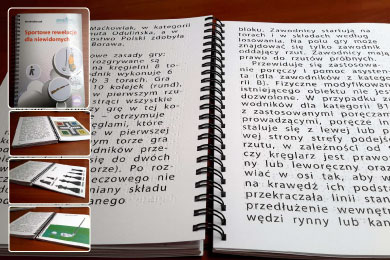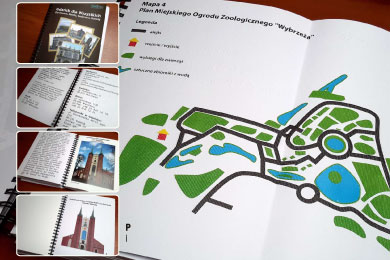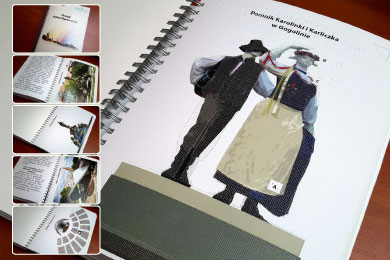We are a specialized print shop for braille printing. We offer a wide range of services including: braille and low vision publications, flyers, posters, information cards, brochures, tactile graphics (maps, figures, diagrams), calendars, business cards, bookmarks, and even braille printing of postcards or playing cards, as well as braille printing on film.
Braille publications
We can divide our publications into two main types: braille printing and so-called transparent printing. The latter is aimed at a much wider audience, as it is not only for the blind, but also for the visually impaired. Transparent printing involves preparing the text in enlarged print, on which we then superimpose 1:1 braille notation. As a result, each line of the publication conveys, regardless of how it is read, by sight or touch, exactly the same information.
The individual pages that make up the publications can be joined together in several ways. We can do it with staples, in thinner publications that also do not require more presentable covers, or with binding or sew-and-glue binding. Binding, due to the nature of braille, is the most common choice for our customers. The use of any presses that are used to cover traditional books for the sighted would destroy the relief writing. When binding, the spine of the book can be plastic or metal. Although the metal spine visually looks more attractive, the plastic spine is less likely to damage the paper and is safer for the user.
Most often we use covers made of paper with a weight of about 300 g/m2. We also make rigid covers.
I have already mentioned sewn and glued binding. It’s recommended to the most demanding customers. Unfortunately, due to the fact that it is made by hand by a bookbinder, its cost is high.
Flyers, posters, brochures
Braille notation does not have to apply only to publications. Also, all short forms, often serving advertising or informational purposes, are also printed in Braille. These can be blank cards with Braille information alone, as well as cards with any sub-printing, including transparent printing. Prints can be made in various formats, but due to the large size of the six-point braille, we suggest not using formats smaller than A4.
Tactile graphics
Maps, engravings and diagrams are a considerable help for sighted people. Blind people don't have to give them up either. This applies to graphics that are part of publications, as well as to loose-leaf cards. In addition to the descriptive form, many of the guides we have printed try to present information to readers through tactile graphics. These can be diagrams, plans, but also engravings of buildings or depictions of animals, objects or paintings.
Tactile graphics, in order to fulfill their function, should be properly prepared. The most important information, which is to be read by touch, must be properly separated from others, so that they do not merge to form an incomprehensible mosaic.
Tactile graphical forms can be produced on Braille paper, using specialized printers that allow different degrees of highlighting of dots to create varied and tactile textures.
Another way to create tactilely legible graphics is to use so-called swell paper. This is a special paper, one side of which, after drawing designs on it with the appropriate ink, swells under the influence of temperature. Only designs created with black color are highlighted.
Regardless of the form, relief prints are realized in formats from A4 to A3. A smaller format may make it impossible to legibly reproduce the content of the graphics to be recognizable by touch.
Calendars
The Braille calendars we offer are A3 format hanging calendars. Each page is divided into two sections. The upper, illustrative one, where there can be relief graphics or a description in braille in place of graphics for the sighted, and the lower one with a table of dates.
Business cards, bookmarks, etc.
We also offer business cards or bookmarks with braille. However, it should be noted here that the size of the braille is specified and cannot be changed. A six-point braille bookmark takes up a lot of space and a standard one-sided business card usually holds a name, surname and phone number. To include more information, double-sided printing can be done, and even if this size is insufficient, the business card can be folded.
Some of our projects:
|
1. Transparent print, binding and adaptation of the book „Sportowe rewelacje dla niewidomych” made for The Chance for the Blind Foundation
|
2. Transparent print, binding and adaptation of the book „Gdańsk dla Wszystkich” made for The Chance for the Blind Foundation
|
3. Transparent print, binding and adaptation of the book „Dotknij pięknej Opolszczyzny” made for The Chance for the Blind Foundation
|
 |
 |
 |